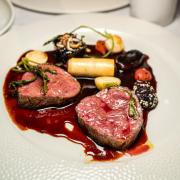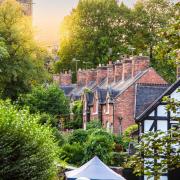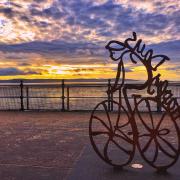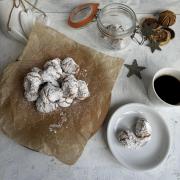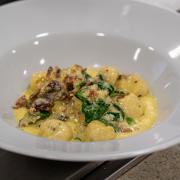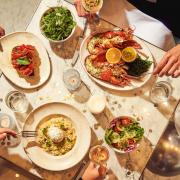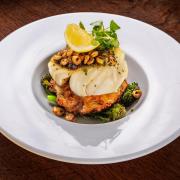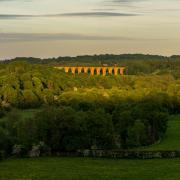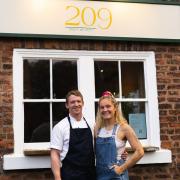There is never a better way to understand a place and its people than through its food, and Manchester as a city is no exception.
When tasked with creating a mouth-watering itinerary to explore this vast foodie metropolis, it seemed only right to enlist local lad, Rob Kelly from Scranchester Tours to lead the way. Going prepared with an empty stomach and comfortable footwear, I arrived in Manchester on a typically wet and grey day – which felt only fitting – to meet Rob’s guided ‘Eat the City’ walking food tour.
Over the ensuing three and a half hours, we weaved through graffiti-strewn side streets, discovered hidden eaterie, and walked much of the city centre while listening to a fascinating historical narrative punctuated with humour-filled anecdotes and pauses for delicious food.

Eat the City
Beginning the tour at the colourful Manchester Craft and Design Centre (MCAD) on Oak Street, now home to a community of talented artisans felt like a natural starting point and introduction to this historical part of the city. Dubbed Cottonopolis in the 19th century, Manchester (incorporating towns in south and east Lancashire), became the largest cotton spinning region in the world, producing 32 per cent of the global stock and leading Manchester to become the first industrial city.
With many of its 108 cotton mills concentrated in Ancoats, the area surrounding Oldham Street became a bustling shopping and trading district, home to vast warehouses and market halls. Opened in 1873, this section of the vast Smithfield Markets, which incorporated numerous buildings, formed the retail fish market, housing more than 40 traders, until it closed after 100 years in 1973. While many of the market buildings were demolished in the 1970s and 1980s, sections of the Smithfield Market were saved and restored. The first of which reopened its doors as the Manchester Craft Village in 1982, and the place where the phrase The Northern Quarter is rumoured to have been coined.
Following the ceramic-tiled street names and the intriguing street art – remnants of the 2016 Cities of Hope international art exhibition – walk the short distance to Siop Shop on the corner of Tib Street and Silver Jubilee Walk. Owned by proud Welshman Iwan Roberts and Lucy Jackson, Siop Shop has developed somewhat of a cult following enticed by its daily selection of seven quirky doughnut varieties, including vegan alternatives. Having sampled a Wagon Wheel doughnut on this occasion, it is easy to understand the hype. With countless references to the street’s previous existence at the centre of the region’s exotic pet trade, the wall mosaic opposite the entrance to Siop Shop and the various animal sculptures dotted along Tib Street make for a fascinating trail in themselves.

From here, make the short four-minute amble along Foundry Lane – the site of the famous music venue, Band on the Wall – towards the imposing Mackie Mayor, located on the corner of Eagle Street. Another section of the Smithfield Markets, this Grade II-listed site is the only remaining intact building in the complex, opened in 1858 and used to trade fresh produce. After lying derelict since the early 1990s, the magnificent building was reimagined by Muse, utilising the familiar communal market-hall concept seen at the business's award-winning Altrincham Market, and opened in 2017. Honouring the bare bones of the building, the reclaimed gymnasium flooring, low-hanging lights, and communal tables only add to the ambience. Diners are spoilt for choice with independent eateries including Tender Cow, Mumma’s Fried Chicken, Chilli B, Wave Ramen, Honest Crust, and Eagle Street Coffee. Focus should be given to the flavour-filled tempura fish tacos found at Pico’s, featuring bites of crispy fish, orange habanero dressed cabbage, achiote aioli, pickled onion, and chopped coriander, with a side of lime to squeeze.
Other notable Northern Quarter eateries worth visiting nearby include the highly Instagrammable bakery, Gooey, on the cobbled High Street, The Northern Quarter Restaurant & Bar just opposite, and This & That Café, tucked away on Soap Street. Home to Manchester’s ‘rice and three curries’ dining concept, this popular curry canteen was established in 1984 and still operates out of a tiny café down an inconspicuous alley. En route to the next dining destination, be sure to note The Washhouse, a launderette-themed speakeasy bar located on Shudehill. Open from 4 pm until late, pre-booking is required to enter via a hidden door.

Taking in the National Football Museum, the majestic Corn Exchange, Chetham’s School of Music, and Manchester Cathedral, walk through the bustling shopping streets towards Sam’s Chop House on Chapel Walks (previously sited on Market Street). Established in 1868 by Samuel Studd, brother of Thomas Studd of Mr Thomas’s Chop House, Sam’s Chop House once served as a drinking and dining venue for Manchester’s busy cotton traders. Just steps from the Grade II listed Royal Exchange (constructed in 1867), now home to the Royal Exchange Theatre and Royal Exchange Shopping Centre, this building became an important centre for the trading of spun yarn and finished cotton goods throughout the world. A favourite with Salford-born artist L.S. Lowry, Sam’s Chop House was often frequented by many of Manchester’s 19th-century elite, all keen to drink a pint of the finest local ale and enjoy a plate of home-cooked fare. Like then, not much has changed, and a plate of traditional corned beef hash (beef brisket, poached egg, chunked potatoes, bacon, and homemade brown sauce) is to be enjoyed, surrounded by the caricatures of its drinking alumni and a bronze statue of Lowry himself, perched at the bar.
Just a short walk away, King Street – once home to Manchester’s great banks – now features a host of late-night bars and fine-dining restaurants: Rosso, Grand Pacific, the soon-to-open Gordon Ramsay’s Lucky Cat, and close by, Six by Nico on Spring Gardens. From here, a five-minute stroll down Booth Street brings you to the Chinese Arch on Faulkner Street and the entrance to Manchester’s Chinatown. The second largest Chinatown in the UK and the third largest in Europe, Manchester’s Chinatown became home to the first Chinese settlers to arrive in the city in the early 20th century, with many finding work in the laundry trade. In response to the immigration boom that started in the 1950s, Chinese businesses, including restaurants, supermarkets, financial, and legal services, chose to settle between Charlotte Street and Princess Street. The Happy Seasons Restaurant on Faulkner Street remains a must for traditional Cantonese dishes.
Finish a fascinating day of walking and eating the city back in the Northern Quarter among the familiar streetscapes that have provided the backdrop for many blockbuster movies and TV programmes. As the name suggests, Tariff & Dale sits on the junction of Tariff and Dale Street, occupying the former showroom and warehouse for cotton spinners, Ralph Waller & Co Ltd. With many of the building’s original features retained, the high ceilings and large windows lend themselves to the cool vibe of this laid-back bar and restaurant, serving modern British food, sourdough pizza, craft beers and classic cocktails.

The final stop of the day takes visitors inside the quirky Afflecks indoor market, formerly Affleck’s Palace, on Church Street. Hidden on the first floor, tucked away among the unique independent fashion and lifestyle stores, is Ginger’s Comfort Emporium. This award-winning ice cream bar mixes up its menu regularly to incorporate interesting flavours of ice cream and sorbet with vegan and dairy-free alternatives. A final nod to Manchester’s story of immigration and industry, this diverse city can only fully be understood and appreciated through its food.
Scranchester Tours currently operates four tours weekly, Wednesday to Saturday, lasting 3.5 hours (private and corporate bookings are also available). There are two walking tours, Eat the City, and Explore Ancoats, with prices starting from £60pp, including the full guided walking tour and stops for food along the route. For more information: scranchestertours.com
Cathy Mulhern's illustrations are available to buy at cathyillustration.com
Talking Heads
Jenny Schippers
@jennywritescheshire
Jenny says: Being able to explore a place through its food is the perfect recipe for me. Learning more about what makes Manchester tick was as enlightening as it was mouth-watering. Knowing very little about the city’s history, other than the obvious, I thoroughly enjoyed being guided across Manchester by someone as knowledgeable as Rob. Highlights include trying mead for the first time, which I thoroughly enjoyed, and exploring inside the beautiful Great Hall of the Royal Exchange.

Rob Kelly
Owner, Scranchester Tours
I started Scranchester Tours in 2018. In my previous job working for the Manchester Tourist Board, I really enjoyed telling people about the city and having done a food tour while on holiday in New York, I thought it was a great way to show people around Manchester. I get a lot of locals on the tour who have never been tourists in their own town and it's great to show them their city in a different light. As the food and drink industry is really booming in Manchester, there are so many great places to eat, and I'm always spoiled for choice.






